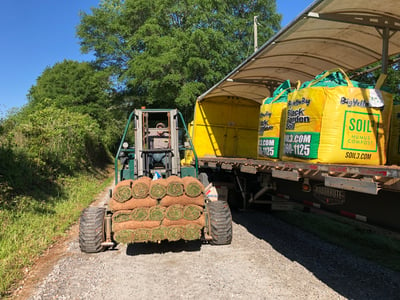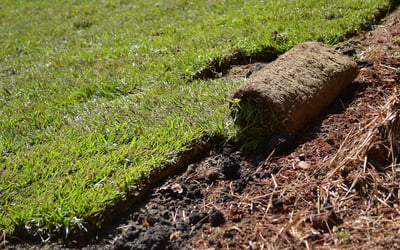
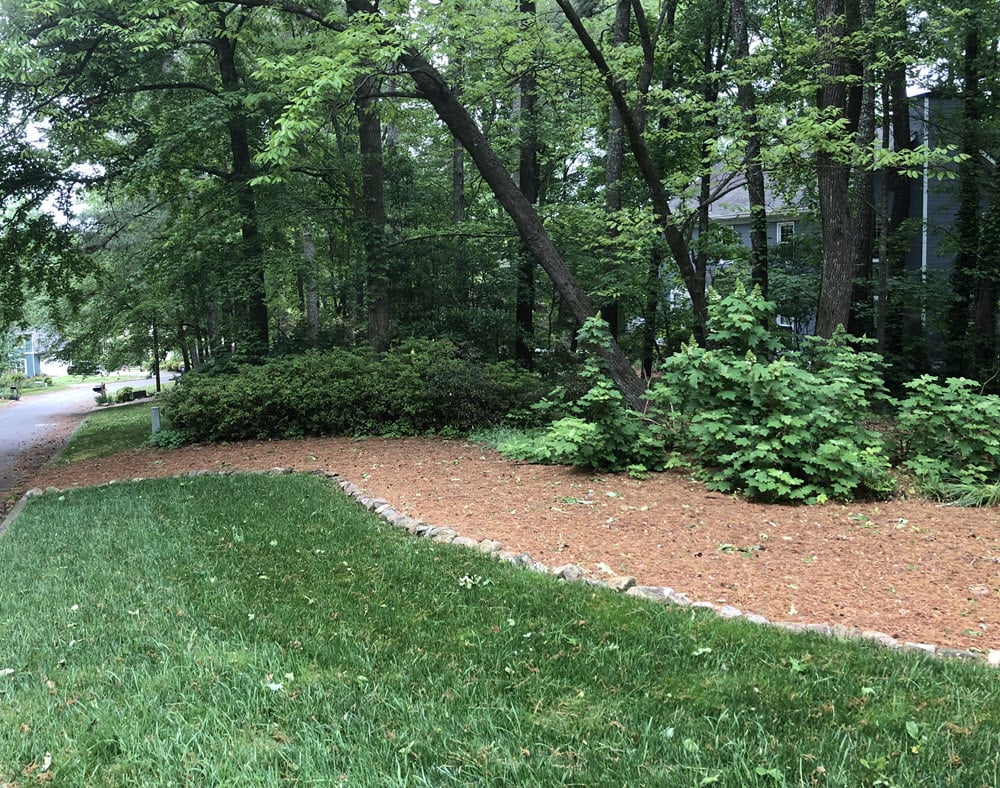
How to Lay Sod Around Trees

While discussing installation of new sod with customers, a very common question I hear is this: How close to the trees can we plant grass? The answer is complicated, and technical, so let’s break it down.
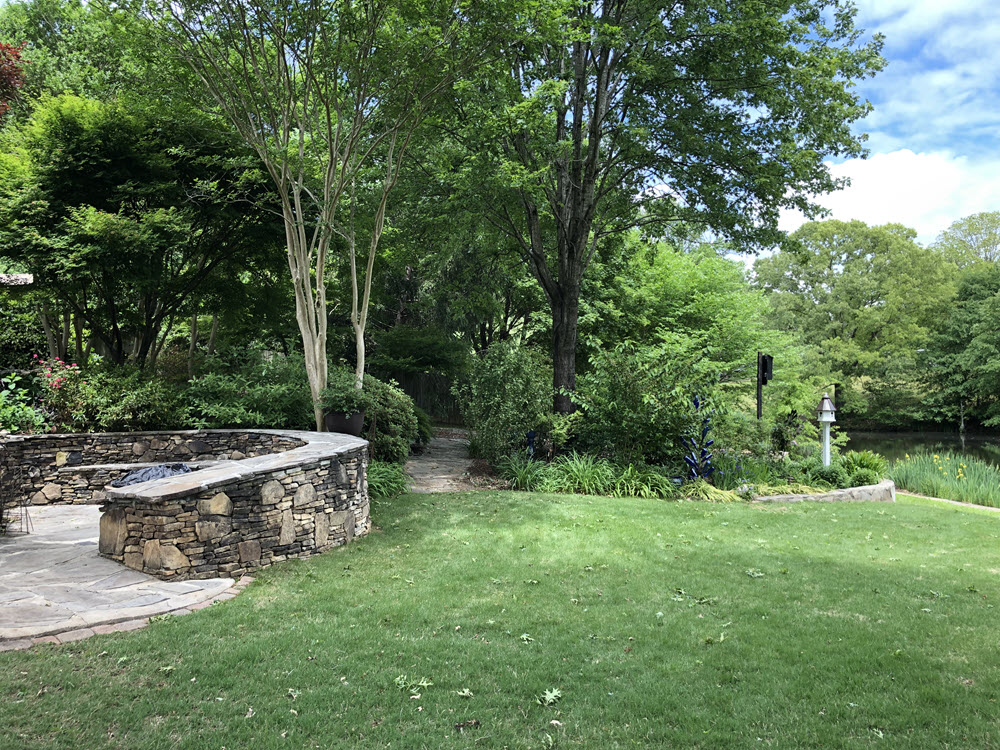
This Bermuda lawn is set back from the trees where it can get at least 5 hours of direct sun each day. Areas of heavy shade closer to the trees are filled with hardscaping and planted beds. Photo by Hillary Thompson.
Competing for Resources
All plants need these things to survive: light, air, water, and nutrients. They also need space to grow and favorable temperatures.
Water and Nutrients
Trees and grass are both seeking water and nutrients from the soil. While the roots of your lawn tend to grow 6-12” deep, tree roots go much deeper and wider so there might be tree roots under your sod fighting for the same resources. This means sod that is growing near trees will require more irrigation and more fertilizer than other parts of your lawn. The need for additional water can be mitigated somewhat by the shade the tree provides, but in a drought the tree will win the battle for available water every time.
Light
While the shade beneath trees helps keep you cool, it is blocking sunlight from reaching the ground where you might want to grow a lawn. Grass, like all plants, needs sunlight to produce food and grow through the process of photosynthesis. Different varieties of grass have different tolerances to shade but they all need a certain amount of direct sunlight every day to thrive. No grass likes heavy shade!
So how do you determine where the sod line should stop as you approach a tree? 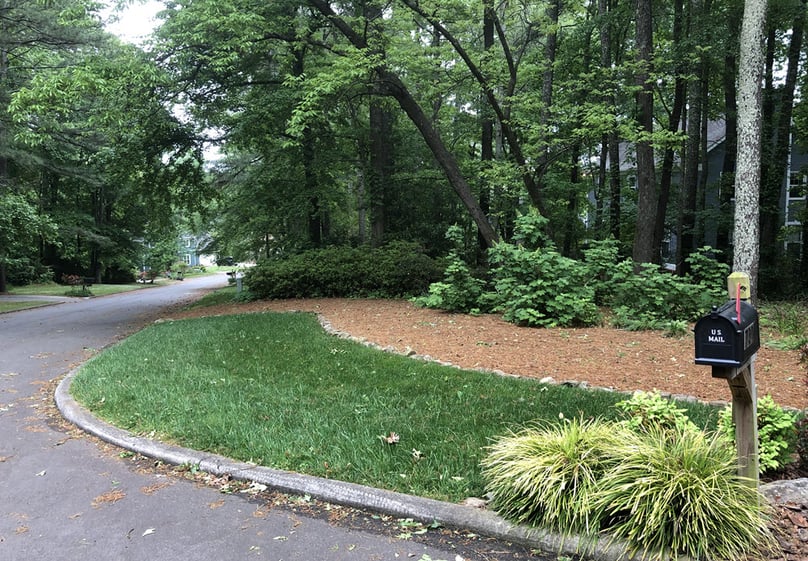
This small area of Tall Fescue lawn adds a lush look to the wooded front yard. The section closer to the trees is too shady for Fescue to grow so a thick layer of pinestraw mulch has been added. Photo by Hillary Thompson.
Getting Technical
First, let's get familiar with some important terms and abbreviations:
- DBH = Diameter at Breast Height. This is the width of the tree trunk measured at a height of approximately 4.5 feet from the ground. It is the standard way to measure a tree.
- SRZ = Structural Root Zone. The area of ground beneath a tree that cannot be disturbed without destabilizing it. SRZ = DBH x 3.5.
Sod should never be planted inside the structural root zone (SRZ) of a tree because the digging and tilling required to prepare for sod can harm the root system and make the tree unstable. - Drip Line = The outermost circumference of the tree's branches. Imagine standing under a tree after a rain shower and finding the point furthest from the trunk where the water drips from the leaves to the ground.
- TPZ = Tree Protection Zone. The area where building should not occur, and heavy machinery should not disturb the roots or compact the soil beneath a tree. TPZ = Drip Line + 3 feet.
If there is enough sunlight, you can lay sod in the TPZ but you should avoid using heavy machinery to grade or prepare the soil within this zone.
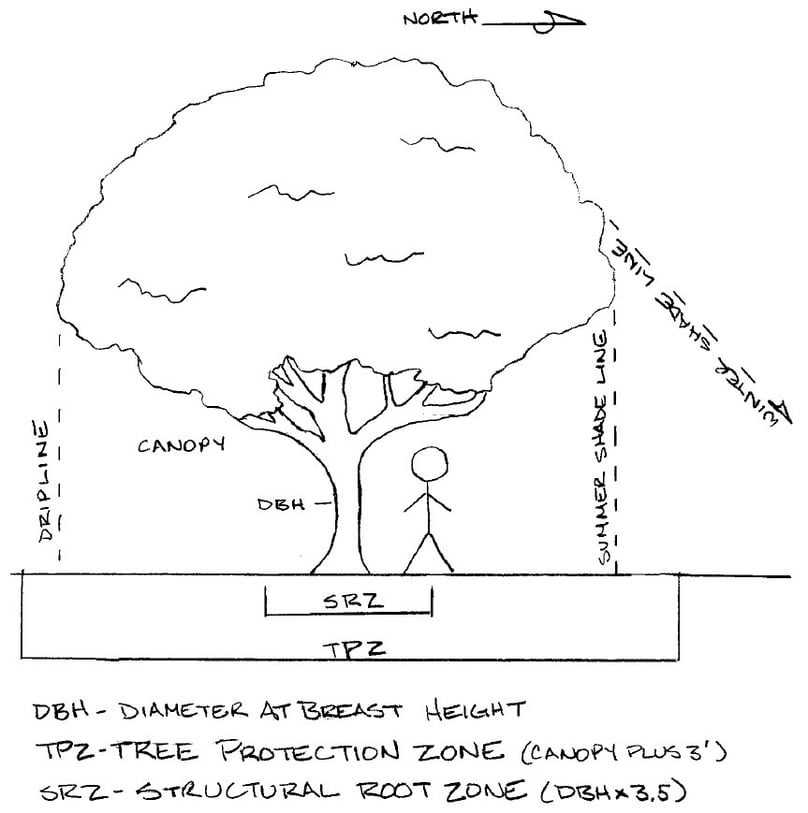
My diagram illustrates some of these measurements and terms. Drawing by Shannon Hathaway.
Let's look at some other terms that are important to understand:
- Orientation = Which way is North? The sun moves from the southern hemisphere in the winter to directly overhead in the summer, tracking east to west through the day. It never moves into the northern hemisphere. Knowing the orientation of your yard is important for understanding areas of shade and calculating your sod line.
- Canopy Height = The canopy is the upper part of the tree - its branches and leaves. The distance from the ground to the bottom of the canopy (the lowest branches) is very important when considering sun angles. The higher the canopy, the more sun can reach in under the branches from the east in the morning and from the west in the afternoon.
- Direct Sun = That means the sun must shine right on the grass or other plants with nothing obstructing its path. This is different than "dappled" or filtered sun where the light passes through branches and leaves before reaching the ground. The needs of specific sod varieties range from 3 to 8 hours of direct sun each day.
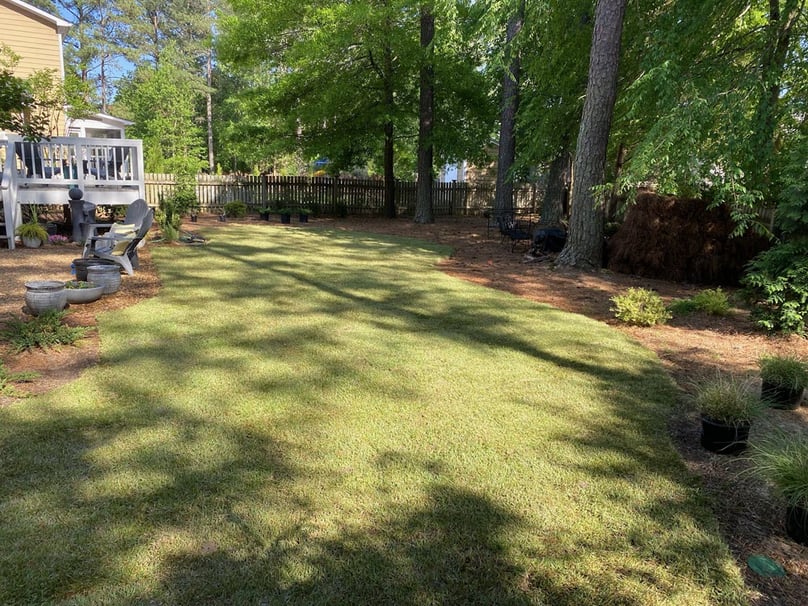
This is a perfect example of "dappled sun". This Zenith Zoysia lawn gets direct sun at other times of day and shady areas close to the trees are mulched. Photo by Iris Ramirez.
Example 1: Canopy Tree
Canopy trees are most often (but not always) deciduous trees. Different tree species have different canopy spreads, so knowing the tree species can be very helpful. Let’s use a red maple as our example. The canopy of a mature red maple is about equal to its height. (For comparison, the canopy of a mature red oak is about 3/4 its height.)
Now let’s do some math. If the diameter at breast height (DBH) of a red maple in your yard is 1 foot then we can calculate the following:
- SRZ = DBH x 3.5. If our DBH is 1 then SRZ = 1 x 3.5. So the structural root zone (SRZ) will be 3.5’ out from the trunk. This is our "no sod" zone.
- Drip line: If the red maple has a DBH of 1’, you can expect it to be about 25’ tall and have a canopy of 25’ in diameter, with a radius of 12.5’. That means the drip line will be 12.5’ out from the trunk, more or less. This can be affected by proximity of other trees or buildings, or by cultivation (have the branches been pruned, for example).
- The TPZ is drip line plus 3 feet. So in our example the Tree Protection Zone will be 15.5’ in radius or 31’ in diameter. Remember you cannot use heavy machinery to prepare the ground for sod within the TPZ.
If you are planting sod on the south side of this red maple with a 1’ DBH, and the canopy is above your head, you can lay sod up to 9 feet (9 x DBH) from the trunk of the tree. On its east and west sides you can come within 12 feet (12 x DBH). On the north side you should avoid the drip line entirely so at least 13-14 feet. Notice this is not a perfect circle! The ground beneath the south side of your tree will receive more sun and under the north side it will have more shade.
On the simplified landscape plan below we are looking down onto a garden and the tree marked B in lower left is a canopy tree in the corner of the front yard. In the top right corner you will see North has been marked and is pointing toward the back of the yard. Notice how the line that marks the edge of the proposed lawn goes under the drip line on the southern side of the canopy tree and then is much further away from the drip line on the north side. 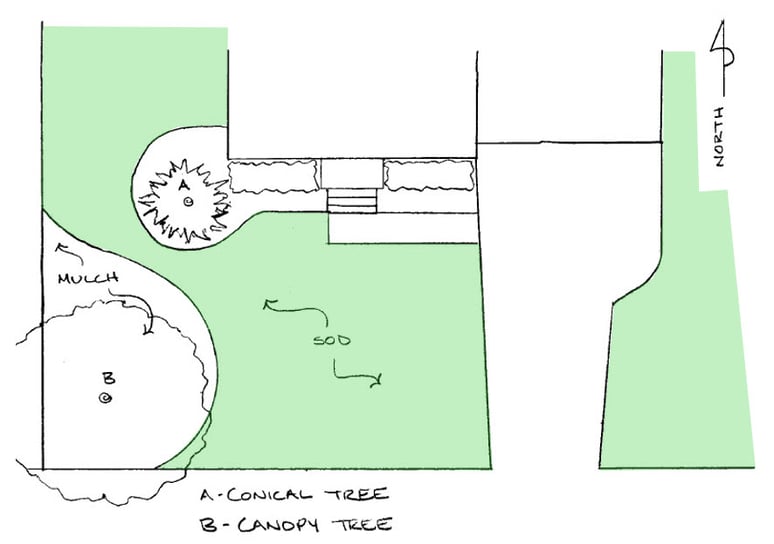
This simple landscape plan shows where the sod line for a new lawn should be to accommodate two trees in the yard. Drawing by Shannon Hathaway.
Example 2: Conical Tree
Conical trees are most often (but not always) evergreen and are shaped like upside-down ice-cream cones. Let’s use a Green Giant arborvitae as our example. The widest part is not above your head but at your feet because the branches grow almost to the ground and that means you cannot grow grass under its base.
However, you CAN bring your sod line in much closer to a conical tree than to a canopy tree because the tree gets narrower as it goes up and it casts less shade than a tree like an oak. On the south side you can bring the sod within 1-2’ of the reach of the lowest branches. On the east and west sides you can do the same. On the north side, however, you will need to stay 4-5’ away from the reach of the lowest branches. On the landscape plan above, the tree marked A at the corner of the house is a conical tree.
As the tree grows, the sod line will likely shrink back. That is because the shade line will increase, as will competition for water and nutrients from the tree roots.
Solutions for Shady Yards
When I meet with clients and we discuss the reality of the tree canopy, many ask, “So how can I have a lawn with all these trees?” The answer is threefold:
- A lawn can come closer to the tree if it is a more shade tolerant type of grass. Our most shade tolerant varieties are Tall Fescue and Zeon Zoysia, which have a minimum requirement of 4 hours of direct sun per day. TifTuf Bermuda is another excellent option - it is shade tolerant (unlike standard Bermuda) needing only 5 hours of direct sun plus it is drought tolerant too.
- You can raise the canopy by removing the lower branches of the trees to allow more light to angle in.
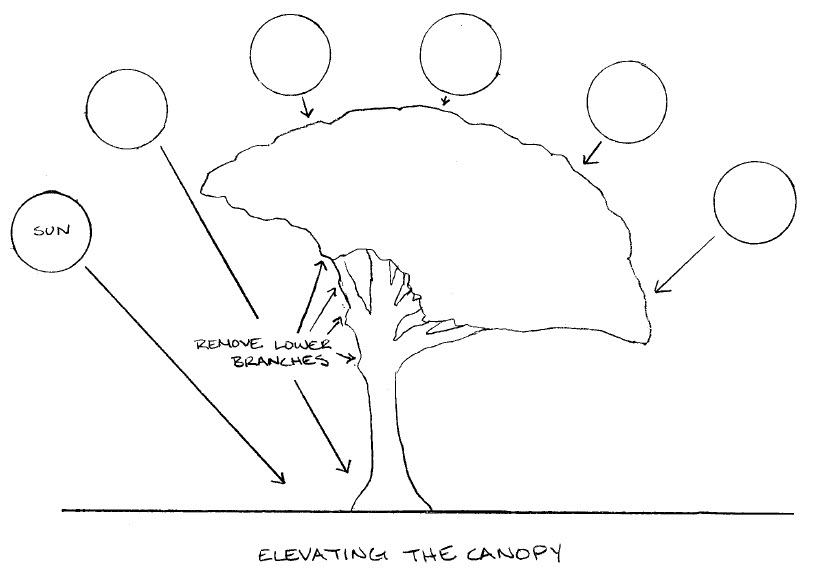
- The last option is to selectively remove some trees for a sunnier yard. Keep in mind that you can only remove trees on your own property! And many HOAs and municipalities have regulations on tree removal so please obey those rules and laws.
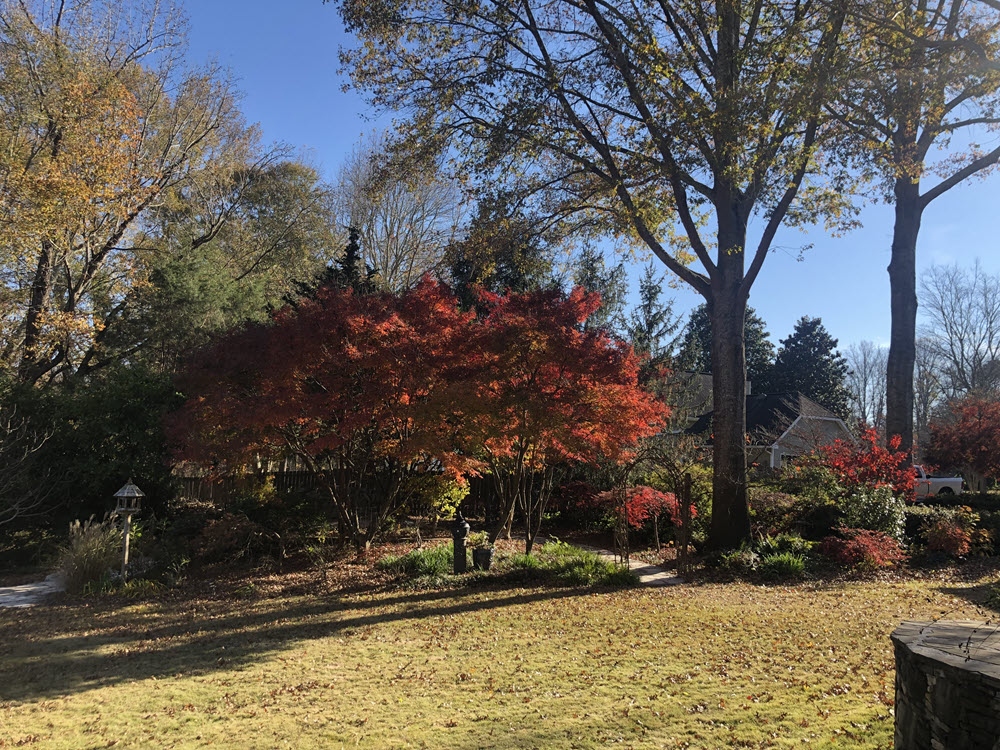
The lower limbs have been trimmed from two tall trees on the right to reduce the amount of shade on this Bermuda lawn. Photo by Hillary Thompson.
Grass vs. Tree?
Now you know how close to the trees you can plant grass and with careful planning you can have a beautiful lawn. Follow these guidelines for success because the game of grass vs. tree is like a Pop Warner football team vs. the Georgia Bulldogs. We all know who will win!
Got more questions about grass for shady yards? Click that link to see other resources to help you answer all those questions or stop by your local Super-Sod store and talk to one of our experts.




